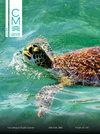墨西哥纳亚里特Boca de Camichín不同潮位下牡蛎袋育苗期养殖的cortezicrasstrea生长、存活和形态计量学关系
IF 0.7
4区 生物学
Q4 MARINE & FRESHWATER BIOLOGY
引用次数: 0
摘要
在墨西哥Nayarit的Boca de Camichín (BC),确定了在生长中期(壳长39.3 ~ 60.2 mm)设置潮间带牡蛎床系统(IOBS)培养corteziensis的最佳潮高。每天记录3次温度、盐度、叶绿素a (Chla)和浊度。利用Chla和浊度数据计算营养状态指数(TSI)。试验了3种与潮位相对应的处理:(1)高水位处理(平均海平面以上14 cm,浸没时间[ET] =试验总持续时间的56.4%),(2)中等水位处理(平均海平面以上,ET = 48.6%),(3)低水位处理(平均海平面以下41 cm, ET = 32.1%)。计算了总增长率、绝对和相对月增长率,以确定相对于环境条件而言增长率最高的时期。最后,研究了不同处理对生蚝尺寸和重量的影响。结果表明:4 ~ 6月为中营养化,7 ~ 8月为富营养化。低潮时最适合IOBS作业,壳长、壳宽和壳厚分别增长0.15、0.10和0.07 mm·d-1,湿重增长0.204 g·d-1。低治疗组(18.5%)和中治疗组(16.4%)的累积死亡率较低。壳体厚度显著减小(P <高、中处理总湿重降低,高、中处理总湿重降低。本研究的结果为目前在墨西哥纳亚里特Boca de Camichín进行的串栽培C. corteziensis提供了一种可行的和不同的替代方案。本文章由计算机程序翻译,如有差异,请以英文原文为准。
Growth, survival, and morphometric relationships of Crassostrea corteziensis cultivated during the nursery stage in oyster bags at different tidal levels, in Boca de Camichín, Nayarit, Mexico
The optimal tide height at which the intertidal oyster bed system (IOBS) should be installed to cultivate Crassostrea corteziensis in Boca de Camichín (BC), Nayarit, Mexico, during the intermediate grow-out stage (39.3–60.2 mm in shell length) was determined. Temperature, salinity, chlorophyll a (Chla), and turbidity were recorded 3 times a day. A trophic state index (TSI) was calculated with Chla and turbidity data. Three treatments corresponding to tide levels were tested: (1) high level (14 cm above mean sea level [MSL], emersion time [ET] = 56.4% of the total duration of the experiment), (2) intermediate level (MSL, ET = 48.6%), and (3) low level (41 cm below MSL, ET = 32.1%). Gross growth rates and absolute and relative monthly growth rates were calculated to identify periods with highest growth relative to environmental conditions. Finally, the effect of the treatments on the dimensions and weight of the oysters was studied. The results indicate that BC water was mesotrophic in April–June and eutrophic in July–August. The low tide level was the best for IOBS operation, with growth rates of 0.15, 0.10, and 0.07 mm·d–1 in shell length, width, and thickness, respectively, and 0.204 g·d–1 wet weight. Cumulative mortality was lower in the low (18.5%) and intermediate (16.4%) treatments. Shell thickness was significant reduced (P < 0.05) in the high treatment and total wet weight was reduced in the high and intermediate treatments. The results of this study offer a viable and different alternative to the cultivation of C. corteziensis in strings that is currently carried out in Boca de Camichín, Nayarit, Mexico.
求助全文
通过发布文献求助,成功后即可免费获取论文全文。
去求助
来源期刊

Ciencias Marinas
生物-海洋与淡水生物学
CiteScore
1.10
自引率
0.00%
发文量
9
审稿时长
>12 weeks
期刊介绍:
A bilingual open-access publication, Ciencias Marinas (CM) is an international peer-reviewed journal that contains original research findings in all areas of marine science. It is published quarterly by the Autonomous University of Baja California, Mexico, and all its contents are publicly available on our journal website. Though a limited number of copies are still printed, the journal is mainly distributed in its electronic format.
CM was conceived in 1973 as part of an academic project aimed to entice local researchers to publicly disclose their findings by adopting the culture of peer-review publishing. This academic project evolved into an international journal after accepting papers from researchers in the United States and, eventually, other parts of the world. Because of the diversity in authorship, CM issues were initially published in either Spanish or English, and occasionally in both languages. It was not until 1984 when CM included both language versions of all its contents, and it then became the fully bilingual journal it still is today. At CM we believe our inclusive format allows us not only to address a wider range of submissions from international authors but also to make published findings available to a wider international audience.
So whether you are looking for information on the redfish in Icelandic waters or the physical and biological properties of the Gulf of California, feel free to peruse CM contents. You may find them to provide source material for your research.
 求助内容:
求助内容: 应助结果提醒方式:
应助结果提醒方式:


